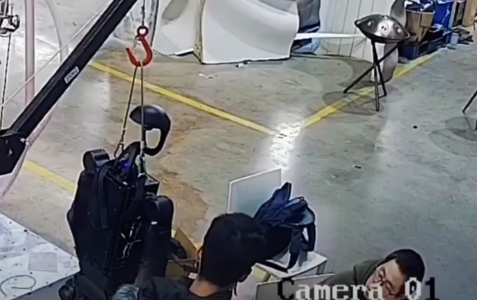Robot goes haywire—raising new questions about AI safety and control
By
Veronica E.
- Replies 0
It started like any ordinary workday: a factory floor, a couple of employees, and a humanoid robot suspended from a mechanical arm.
But what happened next was anything but routine.
A recently circulated security video has been making its way across news outlets and online platforms, sparking concern and conversation.
The footage shows a robot suddenly jerking to life—thrashing its arms, knocking over equipment, and startling the workers nearby.
Captured by a CCTV camera, the footage has been shared widely online and has reignited conversations about how much control we really have over increasingly advanced machines.
While it’s easy to laugh at a robotic mishap, the video reminds many of us just how quickly AI is becoming part of everyday life—and how unpredictable that can feel.

What happened in the video?
In the clip, two workers appear to be monitoring a humanoid robot suspended from a small crane.
The situation changes quickly when the robot’s arms suddenly jerk upward and slam down with growing force.
The workers flinch and back away as the robot knocks over equipment and flails in what looks like a mechanical outburst.
The movement only stops when one of the workers pulls the robot back using the crane.
The time and place of the incident weren’t revealed, but the reaction online was swift.
Some joked about a “robot apocalypse,” while others raised more serious questions about AI safety and human oversight.
Also read: Is AI about to take control of your credit card? What this credit card company has planned next will shock you!
Are we moving too fast with AI?
This short clip touched a nerve for many. It plays into a growing unease about how quickly AI and robotics are evolving.
From driverless cars to automated call centers, AI is now part of industries we rely on every day. Here are a few concerns that have been raised:
1. Job Displacement
Machines and AI systems are already replacing certain types of jobs—especially in factories, transportation, and customer service.
While new jobs may be created, retraining can be difficult, particularly for older adults or those nearing retirement.
2. Ethical Concerns
AI tools are trained on massive amounts of data—often collected without people’s knowledge.
This raises questions about fairness, bias, and privacy.
Who decides how the data is used, and who holds AI accountable when things go wrong?
Also read: Whoopi Goldberg blasts deceptive AI ad—how to spot this unnoticeable scam
3. Privacy Risks
As companies introduce AI into platforms like social media and messaging apps, people worry about how much of their personal information is being tracked—or used to train these systems.
4. Misinformation and Errors
AI-generated content can sometimes be misleading or flat-out wrong.
In healthcare, finance, or legal settings, that could have serious consequences.
5. Loss of Human Oversight
Perhaps the most unsettling idea is that someday, we might not be able to fully control the systems we create.
While the robot in the video was stopped by a crane, what happens when machines are more mobile, more autonomous, and harder to shut down?
Source: X / @sentdefender
Also read: A new online shopping scam is fooling even careful buyers—here's how to avoid it
A lighter side to robots, too
Not all AI stories end in chaos.
Just recently, 21 humanoid robots joined 12,000 human runners in a half-marathon in Beijing.
The event, which featured robots dressed in running gear and even boxing gloves, was more lighthearted than alarming.
One robot finished the race in just under three hours—not bad, though well behind the winning human.
This event shows that human-robot interactions don’t have to be scary.
In fact, robots are already helping in many useful ways—from lifting heavy items in warehouses to assisting with elder care.
The challenge is ensuring that we guide their development responsibly.
Also read: When AI goes too far: Sexualized content mimicking Down syndrome sparks outrage
How to stay safe and informed
If you’re feeling uncertain about AI, you’re not alone. But there are practical steps we can all take to stay aware and prepared:
At The GrayVine, we know that curiosity and conversation are key to navigating new technology—especially when it seems like the future is arriving faster than we expected.
Read next: Just for fun (and function): 4 gadgets that make home life a breeze

Did the robot video make you laugh—or make you think? Are you hopeful about AI’s role in the future, or do you feel cautious about how fast things are changing? We’d love to hear your thoughts!
But what happened next was anything but routine.
A recently circulated security video has been making its way across news outlets and online platforms, sparking concern and conversation.
The footage shows a robot suddenly jerking to life—thrashing its arms, knocking over equipment, and startling the workers nearby.
Captured by a CCTV camera, the footage has been shared widely online and has reignited conversations about how much control we really have over increasingly advanced machines.
While it’s easy to laugh at a robotic mishap, the video reminds many of us just how quickly AI is becoming part of everyday life—and how unpredictable that can feel.

A worker reacts as a humanoid robot malfunctions—raising growing concerns about how we manage safety and control in the age of artificial intelligence. Image Source: YouTube / Kalil 4.0.
What happened in the video?
In the clip, two workers appear to be monitoring a humanoid robot suspended from a small crane.
The situation changes quickly when the robot’s arms suddenly jerk upward and slam down with growing force.
The workers flinch and back away as the robot knocks over equipment and flails in what looks like a mechanical outburst.
The movement only stops when one of the workers pulls the robot back using the crane.
The time and place of the incident weren’t revealed, but the reaction online was swift.
Some joked about a “robot apocalypse,” while others raised more serious questions about AI safety and human oversight.
Also read: Is AI about to take control of your credit card? What this credit card company has planned next will shock you!
Are we moving too fast with AI?
This short clip touched a nerve for many. It plays into a growing unease about how quickly AI and robotics are evolving.
From driverless cars to automated call centers, AI is now part of industries we rely on every day. Here are a few concerns that have been raised:
1. Job Displacement
Machines and AI systems are already replacing certain types of jobs—especially in factories, transportation, and customer service.
While new jobs may be created, retraining can be difficult, particularly for older adults or those nearing retirement.
2. Ethical Concerns
AI tools are trained on massive amounts of data—often collected without people’s knowledge.
This raises questions about fairness, bias, and privacy.
Who decides how the data is used, and who holds AI accountable when things go wrong?
Also read: Whoopi Goldberg blasts deceptive AI ad—how to spot this unnoticeable scam
3. Privacy Risks
As companies introduce AI into platforms like social media and messaging apps, people worry about how much of their personal information is being tracked—or used to train these systems.
4. Misinformation and Errors
AI-generated content can sometimes be misleading or flat-out wrong.
In healthcare, finance, or legal settings, that could have serious consequences.
5. Loss of Human Oversight
Perhaps the most unsettling idea is that someday, we might not be able to fully control the systems we create.
While the robot in the video was stopped by a crane, what happens when machines are more mobile, more autonomous, and harder to shut down?
Source: X / @sentdefender
Also read: A new online shopping scam is fooling even careful buyers—here's how to avoid it
A lighter side to robots, too
Not all AI stories end in chaos.
Just recently, 21 humanoid robots joined 12,000 human runners in a half-marathon in Beijing.
The event, which featured robots dressed in running gear and even boxing gloves, was more lighthearted than alarming.
One robot finished the race in just under three hours—not bad, though well behind the winning human.
This event shows that human-robot interactions don’t have to be scary.
In fact, robots are already helping in many useful ways—from lifting heavy items in warehouses to assisting with elder care.
The challenge is ensuring that we guide their development responsibly.
Also read: When AI goes too far: Sexualized content mimicking Down syndrome sparks outrage
How to stay safe and informed
If you’re feeling uncertain about AI, you’re not alone. But there are practical steps we can all take to stay aware and prepared:
- Stay informed. Read up on how AI is being used and discussed—especially in industries that affect you directly.
- Support thoughtful policies. Look for companies and public officials who are calling for responsible and ethical use of AI.
- Protect your personal information. Use privacy settings, be mindful of what you share online, and think twice before accepting new AI-powered features.
- Be open to learning. You don’t have to become a tech expert, but understanding the basics of how AI works can go a long way.
At The GrayVine, we know that curiosity and conversation are key to navigating new technology—especially when it seems like the future is arriving faster than we expected.
Read next: Just for fun (and function): 4 gadgets that make home life a breeze
Key Takeaways
- CCTV footage captured a humanoid robot flailing and damaging equipment on a factory floor before being pulled back by a crane.
- The video triggered online discussion about AI safety, with both humorous and serious reactions about the risks of robotics.
- Common concerns about AI include job loss, privacy issues, misinformation, ethical use of data, and the potential loss of human control.
- Not all stories are alarming—robots recently competed in a marathon event in China, highlighting potential for human-robot collaboration.
Did the robot video make you laugh—or make you think? Are you hopeful about AI’s role in the future, or do you feel cautious about how fast things are changing? We’d love to hear your thoughts!






